DNR lifts live bait ban on Mille Lacs walleye fishing

Live bait will now be allowed on Mille Lacs Lake starting with the May 14 fishing opener, although the catch-and-release only rule for walleye remains in place, DNR officials said Thursday.
Matthew Hintz | For MPR News 2015
Go Deeper.
Create an account or log in to save stories.
Like this?
Thanks for liking this story! We have added it to a list of your favorite stories.


